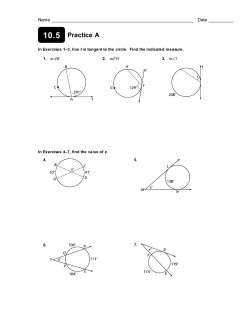
File
DO NOT EDIT--Changes must be made through “File info” CorrectionKey=NL-A;CA-A Name Class Date 13.1TangentRatio Essential Question: How do you find the tangent ratio for an acute angle? Resource Locker Explore Investigating a Ratio in a Right Triangle In a given a right triangle, △ABC, with a right angle at vertex C, there are three sides. The side adjacent to ∠A is the leg that forms one side of ∠A. The side opposite ∠A is the leg that does not form a side of ∠A. The side that connects the adjacent and opposite legs is the hypotenuse. B Hypotenuse A Leg opposite to ∠A Leg adjacent to ∠A C In △DEF, label the legs opposite and adjacent to ∠D. Then measure the lengths of the legs in centimeters and record their values in the rectangles provided. E Measurements may vary slightly. opposite 2.5 cm © Houghton Mifflin Harcourt Publishing Company F 40° 3.1 cm adjacent D What is the ratio of the opposite leg length to the adjacent leg length, rounded to the nearest hundredth? EF ≈ 0.81 Ratios may vary slightly depending on measurements. _ DF △JKL with a right angle at vertex L and ∠J = 40° so that △JKL ~ △DEF. Label the opposite and adjacent legs to ∠J and Using a protractor and ruler, draw right triangle include their measurements. Drawings will vary but should be similar to the triangle in Step A. For all triangles, it is true that opposite length < adjacent length. What is the ratio of the opposite leg length to the adjacent leg length, rounded to the nearest hundredth? KL ≈ _ 0.81 JL Module13 GE_MNLESE385801_U5M13L1.indd 687 687 Lesson1 4/2/14 9:31 AM DO NOT EDIT--Changes must be made through “File info” CorrectionKey=NL-A;CA-A DO NOT Correcti Reflect 1. Discussion Compare your work with that of other students. Do all the triangles have the same angles? Do they all have the same side lengths? Do they all have the same leg ratios? Summarize your findings. The triangles are all similar, so they have angles that have the same measure but not the same side lengths. Yet, for a given angle, the ratio of the length of the opposite leg to the length of the adjacent leg is constant. 2. If you repeated Steps A–D with a right triangle having a 30° angle, how would your results be similar? How would they be different? The triangles would all be similar, with the ratio of the length of the leg opposite the 30° angle to the length of the leg adjacent to the 30° angle constant, but the actual value of the ratio would be different from 0.81. Finding the Tangent of an Angle Explain 1 The ratio you calculated in the Explore section is called the tangent of an angle. The tangent of acute angle A, written tan ∠A, is defined as follows: length of leg opposite ∠A tan A = ___ length of leg adjacent to ∠A You can use what you know about similarity to show why the tangent of an angle is constant. By the AA Similarity Postulate, given ∠ D ≅ ∠J and also ∠ F ≅ ∠L, then △DEF ~ △JKL. This means the lengths of the sides of △JKL are each the same multiple, k, of the lengths of the corresponding sides of △DEF. Substituting into the tangent equation shows that the ratio of the length of the opposite leg to the length of the adjacent leg is always the same value for a given acute angle. E 40° F tangent defined for specified angle △DEF D J Example 1 Find the tangent of each specified angle. Write each ratio as a fraction and as a decimal rounded to the nearest hundredth. C ∠A 18 ∠B B length of leg opposite ∠ A 18 = _ 3 = 0.75 tan A = ___ = _ 4 24 length of leg adjacent to ∠ A 4 24 length of leg opposite ∠ B tan B = ___ = _ = _ ≈ 1.33 3 length of leg adjacent to ∠ B 18 Module13 GE_MNLESE385801_U5M13L1.indd 688 688 24 A © Houghton Mifflin Harcourt Publishing Company 40° ⎧ k∙DF ⎪ L ⎨ leg opposite ∠ 40° k·EF = _ KL = _ EF EF = _ tan 40° = __ = _ JL k·DF DF DF leg adjacent to ∠ 40° k∙DE k∙EF ⎪ ⎪ ⎪ ⎩ K △JKL 30 Lesson1 25/03/14 10:52 AM DO NOT EDIT--Changes must be made through “File info” CorrectionKey=NL-A;CA-A Reflect 3. What is the relationship between the ratios for tan A and tan B? Do you believe this relationship will be true for acute angles in other right triangles? Explain. The ratios are reciprocals of each other. This will always be true because the opposite side of one acute angle is the adjacent side of the other acute angle, and vice versa. 4. Why does it not make sense to ask for the value of tan L? The tangent ratio is defined only for the acute angles of a right triangle, not for the right angle. Your Turn Find the tangent of each specified angle. Write each ratio as a fraction and as a decimal rounded to the nearest hundredth. 5. ∠Q 6. 15 5 tan ∠ Q = _ = _ ≈ 0.42 36 12 Q ∠R 36 39 S 15 R 36 12 tan ∠ R = _ = _ = 2.4 5 15 Finding a Side Length using Tangent Explain 2 When you know the length of a leg of a right triangle and the measure of one of the acute angles, you can use the tangent to find the length of the other leg. This is especially useful in real-world problems. Example 2 Apply the tangent ratio to find unknown lengths. In order to meet safety guidelines, a roof contractor determines that she must place the base of her ladder 6 feet away from the house, making an angle of 76° with the ground. To the nearest tenth of a foot, how far above the ground is the eave of the roof? © Houghton Mifflin Harcourt Publishing Company C A Step 1 Step 2 76° 6 ft B Write a tangent ratio that involves the unknown length. length of leg opposite ∠A BC tan A = ___ = _ BA length of leg adjacent to ∠A Identify the given values and substitute into the tangent equation. Given: BA = 6 ft and m∠A = 76° BC Substitute: tan 76 °=_ 6 Module13 GE_MNLESE385801_U5M13L1.indd 689 689 Lesson1 22/03/14 12:28 PM DO NOT EDIT--Changes must be made through “File info” CorrectionKey=NL-A;CA-A DO NOT Correcti Step 3 Solve for the unknown leg length. Be sure the calculator is in degree mode and do not round until the final step of the solution. Multiply each side by 6. BC 6 ·_ 6 · tan 76° = _ 1 6 Use a calculator to find tan 76°. 6 · tan 76° = BC Substitute this value in for tan 76°. 6(4.010780934) = BC Multiply. Round to the nearest tenth. 24.1 ≈ BC So, the eave of the roof is about 24.1 feet above the ground. B For right triangle △STU, what is the length of the leg adjacent to ∠S? S 54° Step 1 Write a tangent ratio that involves the unknown length. TU length of leg opposite ∠ S tan S = ___ = _ length of leg adjacent to ∠ S SU T 87 U Step 2 Identify the given values and substitute into the tangent equation. Given: TU = 87 and m∠S = 54 ° 87 Substitute: tan 54 ° = _ SU Step 3 Solve for the unknown leg length. 87 Multiply both sides by SU, then divide both sides by 54°. SU = __ tan 54 ° 87 Use a calculator to find 54° and substitute. SU ≈ __ Divide. Round to the nearest tenth. SU ≈ 63.2 1.37638192 7. © Houghton Mifflin Harcourt Publishing Company Your Turn A ladder needs to reach the second story window, which is 10 feet above the ground, and make an angle with the ground of 70°. How far out from the building does the base of the ladder need to be positioned? 10 10 10 _____ __ 3.6 ft; tan 70° = __ x , so x = tan 70° ≈ 2.747477419 ≈ 3.6 Explain 3 Finding an Angle Measure using Tangent In the previous section you used a given angle measure and leg measure with the tangent ratio to solve for an unknown leg. What if you are given the leg measures and want to find the measures of the acute angles? If you know the tan A, read as “tangent of ∠A,” then you can use the tan -1 A, read as “inverse tangent of ∠A,” to find m∠A. So, given an acute angle ∠A, if tan A = x, then tan -1 x = m∠A. Module 13 GE_MNLESE385801_U5M13L1.indd 690 690 Lesson 1 22/03/14 12:28 PM DO NOT EDIT--Changes must be made through “File info” CorrectionKey=NL-A;CA-A B Example 3 Find the measure of the indicated angle. Round to the nearest degree. 19 in. What is m∠A? A 36 in. C Step 1 Write the tangent ratio for ∠ A using the known values. Step 2 Write the inverse tangent equation. Step 3 Evaluate using a calculator and round as indicated. 19 tan A = _ 36 19 tan -1 _ = m∠ A 36 m∠ A ≈ 27.82409638 ≈ 28° What is m∠B? Step 1 Write the tangent ratio for ∠ B using the known values. Step 2 Write the inverse tangent equation. 36 tan -1 tan B = _____ 36 _____ = m∠ B 19 19 Step 3 Evaluate using a calculator and round as indicated. ° ° m∠ B ≈ 62.17590362 ≈ 62 Your Turn 8. J Find m∠J. K 46 26°, m∠J =tan -1 __ ≈ 26.31808814 93 93 © Houghton Mifflin Harcourt Publishing Company 46 L Elaborate 9. Explain how to identify the opposite and adjacent legs of a given acute angle. The opposite leg does not form a side of the given angle. The adjacent leg forms a side of the given angle and is not the hypotenuse. 10. Discussion How does tan A change as m∠A increases? Explain the basis for the identified relationship. Tan A increases as m∠A increases. As m∠A increases, the length of the leg adjacent to ∠A remains the same and the length of the leg opposite ∠A increases. Since the length of the opposite leg is the numerator of the tangent ratio, and the denominator of that ratio does not change, the ratio increases. Module13 GE_MNLESE385801_U5M13L1.indd 691 691 Lesson1 22/03/14 12:28 PM
© Copyright 2025









